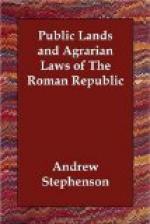Argument of the Lex Thoria.[26]
The law evidently consists of three parts, although the rubricae are absent.
I. De agro publico p. R. in Italia (1-43).
II. De agro publico p. R. in Africa (44—95).
III. De agro publico p. R. qui Corinthorum fuit (96-105).
I. On the Ager Publicus in Italy.
This part may be divided roughly into three sections: (1) Lines 1-24, defining ager privatus; (2) 24-32, defining ager publicus; (3) 33-43, on disputed cases.
It thus embraces the first forty-three lines of the law, and is concerned with the public land of Italy, from the Rubicon southwards. It commences by referring to the condition of this land in the year 133, when Tiberius Gracchus was tribune. The law does not affect to touch any thing which had been enacted concerning this land prior to 133. It either confirms or alters what had been done in 133, and since that time. All the public land which was exempted from the operation of the Sempronian laws, i.e., Ager Campanus and Ager Stellatis, was also excluded from the operation of the lex Thoria.
(1) The first ten lines of the law relate to that part of the ager publicus which was occupied before the time of the Gracchi, if the amount of such land did not exceed the maximum fixed by the Sempronian laws;
(2) Also, to the assignments made by lot (sortito) to Roman citizens by the commissioners since the enactment of the Sempronian laws, if such assignments were not made out of land which had been guaranteed to the old possessors;
(3) Also, to all lands taken from an old possessor, but on his complaint restored to him by the commissioners;
(4) Also, to all houses and lands, in Rome or in other parts of Italy, which the commissioners had granted without lot, so as such grants did not interfere with the guaranteed title of older possessors;
(5) Also, to all the public land which Gaius Sempronius, or the commissioners, in carrying out his law, had used in the establishment of colonies or given to settlers, whether Roman citizens, Latini, or Italian Socii, or which they had caused to be entered on the “formae” or “tabulae.”
All the lands comprised in the above are declared in lines seven and eight to be private property, in these words: “Ager locus omnis quei supra scriptus est, extra eum agrum locum, quei ager locus ex lege plebeivescito, quod C. Sempronius Ti. f. tr. pl. rogavit, exsceptum cavitumve est nei divideretur ... privatus esto.”




